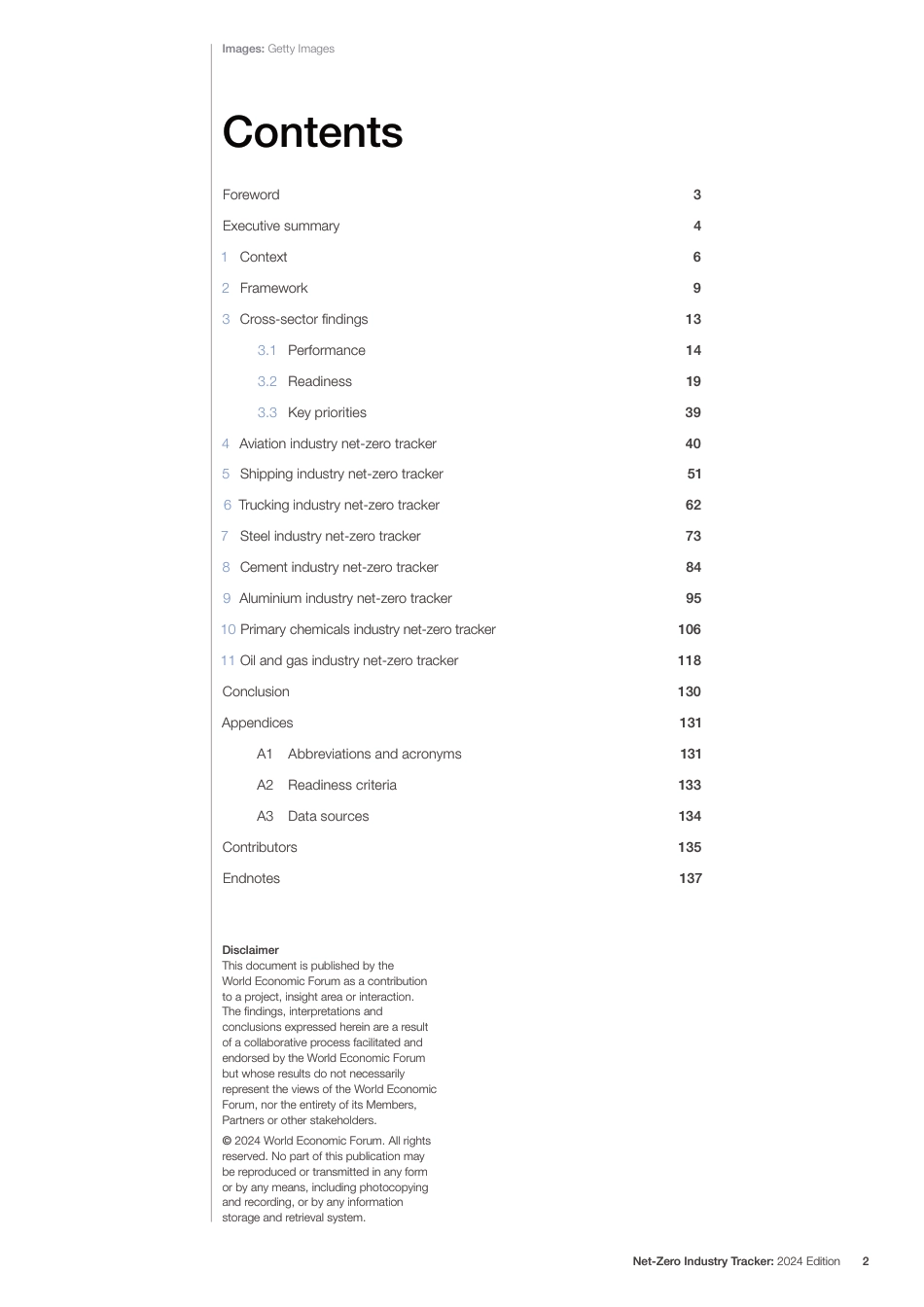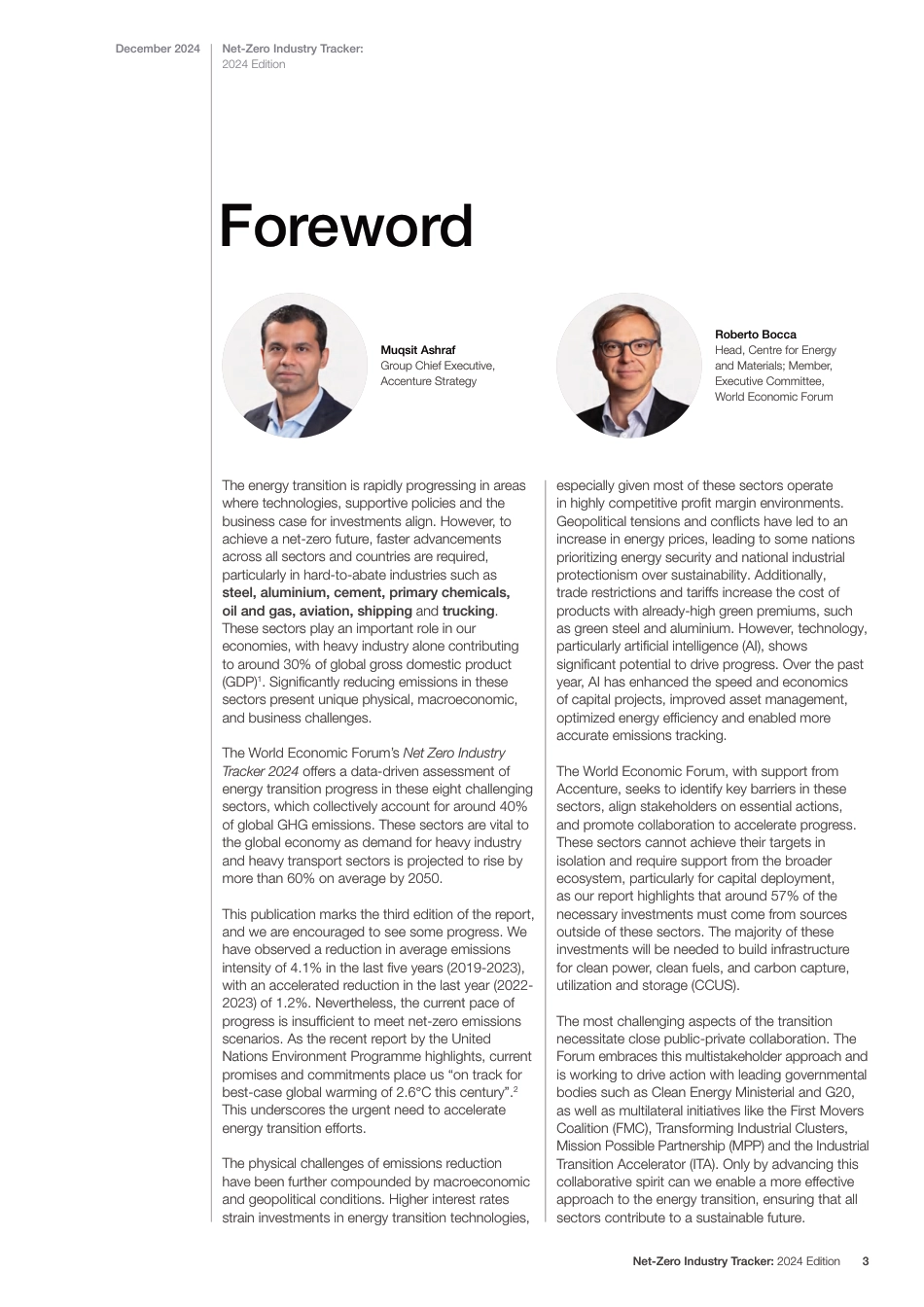Net-ZeroIndustryTracker2024EditionINSIGHTREPORTDECEMBER2024IncollaborationwithAccentureImages:GettyImagesDisclaimerThisdocumentispublishedbytheWorldEconomicForumasacontributiontoaproject,insightareaorinteraction.Thefindings,interpretationsandconclusionsexpressedhereinarearesultofacollaborativeprocessfacilitatedandendorsedbytheWorldEconomicForumbutwhoseresultsdonotnecessarilyrepresenttheviewsoftheWorldEconomicForum,northeentiretyofitsMembers,Partnersorotherstakeholders.©2024WorldEconomicForum.Allrightsreserved.Nopartofthispublicationmaybereproducedortransmittedinanyformorbyanymeans,includingphotocopyingandrecording,orbyanyinformationstorageandretrievalsystem.ContentsForeword3Executivesummary41Context62Framework93Cross-sectorfindings133.1Performance143.2Readiness193.3Keypriorities394Aviationindustrynet-zerotracker405Shippingindustrynet-zerotracker516Truckingindustrynet-zerotracker627Steelindustrynet-zerotracker738Cementindustrynet-zerotracker849Aluminiumindustrynet-zerotracker9510Primarychemicalsindustrynet-zerotracker10611Oilandgasindustrynet-zerotracker118Conclusion130Appendices131A1Abbreviationsandacronyms131A2Readinesscriteria133A3Datasources134Contributors135Endnotes137Net-ZeroIndustryTracker:2024Edition2ForewordTheenergytransitionisrapidlyprogressinginareaswheretechnologies,supportivepoliciesandthebusinesscaseforinvestmentsalign.However,toachieveanet-zerofuture,fasteradvancementsacrossallsectorsandcountriesarerequired,particularlyinhard-to-abateindustriessuchassteel,aluminium,cement,primarychemicals,oilandgas,aviation,shippingandtrucking.Thesesectorsplayanimportantroleinoureconomies,withheavyindustryalonecontributingtoaround30%ofglobalgrossdomesticproduct(GDP)1.Significantlyreducingemissionsinthesesectorspresentuniquephysical,macroeconomic,andbusinesschallenges.TheWorldEconomicForum’sNetZeroIndustryTracker2024offersadata-drivenassessmentofenergytransitionprogressintheseeightchallengingsectors,whichcollectivelyaccountforaround40%ofglobalGHGemissions.Thesesectorsarevitaltotheglobaleconomyasdemandforheavyindustryandheavytransportsectorsisprojectedtorisebymorethan60%onaverageby2050.Thispublicationmarksthethirdeditionofthereport,andweareencouragedtoseesomeprogress.Wehaveobservedareductioninaverageemissionsintensityof4.1%inthelastfiveyears(2019-2023),withanacceleratedreductioninthelastyear(2022-2023)of1.2%.Nevertheless,thecurrentpaceofprogressisinsufficienttomeetnet-zeroemissionsscenarios.AstherecentreportbytheUnitedNationsEnvironmentProgrammehighlights,currentpromisesandcommitmentsplaceus“ontrackforbest-caseglobalwarmingof2.6°Cthiscentury”.2Thisunderscorestheurgentneedtoaccelerateenergytransitionefforts.Thephysicalchallengesofemissionsreductionhavebeenfurthercompoundedbymacroeconomicandgeopoliticalconditions.Higherinterestratesstraininvestmentsinenergytransitiontechnologies,especiallygivenmostofthesesectorsoperateinhighlycompetitiveprofitmarginenvironments.Geopoliticaltensionsandconflictshaveledtoanincreaseinenergyprices,leadingtosomenationsprioritizingenergysecurityandnationalindustrialprotectionismoversustainability.Additionally,traderestrictionsandtariffsincreasethecostofproductswithalready-highgreenpremiums,suchasgreensteelandaluminium.However,technology,particularlyartificialintelligence(AI),showssignificantpotentialtodriveprogress.Overthepastyear,AIhasenhanced...



 VIP
VIP VIP
VIP VIP
VIP VIP
VIP VIP
VIP VIP
VIP VIP
VIP VIP
VIP VIP
VIP VIP
VIP